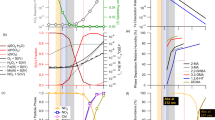Abstract
The heterogeneous removal of N2O5 by sulphuric acid aerosols as been invoked to explain the decline of mid-latitude ozone in the last decade. We have used a photochemical model to study measurements of odd-nitrogen made by Spacelab 3. The gas-phase photochemical model overestimates the amount of N2O5 present. The loss of N2O5 by aerosols does reduce N2O5, but is likely to be slower than assumed in WMO (1992). The sunset measurements at 25.5 km cannot be explained by heterogeneous loss of N2O5 and is more likely to be due to a faster photolysis than assumed. New absorption cross-sections of HNO3 reduce the photolysis of HNO3 so that the model with gas-phase chemistry only gives better agreement at 19 km, than a model including heterogeneous chemistry.
Similar content being viewed by others
References
Allen, M. and Delitsky, M. L., 1990, Stratospheric NO, NO2, and N2O5: A comparison of model results with Spacelab 3 Atmospheric Trace Molecule Spectroscopy measurements,J. Geophys. Res. 95, 14,077–14,082.
Arnold, F., Buhrke, Th., and Qiu, S., 1990, Evidence for stratospheric ozone-depleting heterogeneous chemistry on volcanic aerosols from El Chichon,Nature 348, 49–50.
Austin, J., Garcia, R. R., Russell III, J. M., and Solomon, S., 1986, On the atmospheric photochemistry of nitric acid,J. Geophys. Res. 91, 5477–5485.
Bekki, S., Toumi, R., Pyle, J. A., and Jones, A. E., 1991. Future aircraft and global ozone,Nature 354, 193–194.
DeMore, W. B., Molina, M. J., Sander, S. P., Hampson, R. F., Kurylo, M. J., Golden, D. M., Howard, C. J., and Ravishankara, A. R., 1990, Chemical kinetics and photochemical data for use in stratospheric modeling, evaluation No. 9, JPL Publication 90-1.
Fabian, P., Pyle, J. A., and Wells, R. J., 1982, Diurnal variations of minor constituents in the stratosphere modeled as a function of latitude and season,J. Geophys. Res. 87, 4981–5000.
Hanson, D. R. and Ravishankara, A. R., 1991, The reaction probabilities of ClONO2 and N2O5 on 40 to 75% sulfuric acid solutions,J. Geophys. Res. 96, 17,307–17,314.
Kurzeja, R. J., 1977, Effects of diurnal variations and scattering on ozone in the stratosphere for present-day and predicted future chlorine concentrations,J. Atmos. Sci. 34, 1120–1129.
Lacis, A. A. and Hansen, J. E., 1974, A parameterisation for the absorption of solar radiation in the earth's atmosphere,J. Atmos. Sci. 31, 118–133.
Natarajan, M. and Callis, L. B., 1991, Stratospheric photochemical studies with atmospheric trace molecule spectroscopy (ATMOS) measurements,J. Geophys. Res. 96, 9361–9370.
Nicolet, M., 1984, On the molecular scattering in the terrestrial atmosphere: An empirical formula for its calculation in the homosphere,Planet. Space Sci. 32, 1467–1468.
Gunson, M. R., Farmer, C. B., Norton, R. H., Zander, R., Rinsland, C. P. Shaw, J. H., and Bo-Cai, Gao, 1990, Measurements of CH4, N2O, CO, H2O and O3 in the middle atmosphere by the ATMOS experiment on Spacelab 3,J. Geophys. Res. 95, 13,867–13,882.
Hofmann, D. J. and Solomons, S., 1989, Ozone destruction following eruption of El Chichon,J. Geophys. Res. 94, 5029–5041.
Mozurkewich, M. and Calvert, J. G., 1988, Reaction probability of N2O5 on aqueous aerosols,J. Geophys. Res. 93, 15,889–15,896.
Pyle, J. A. and Toumi, R., 1990, Testing of photochemical theory with solar occultation data,J. Atmos. Chem. 11, 227–243.
Raper, O. F., Farmer, C. B., Zander, R., and Park, J. H., 1987, Infrared spectroscopic measurements of halogenated sink and reservoir gases in the stratosphere from the ATMOS Spacelab 3 mission,J. Geophys. Res. 92, 9851–9858.
Rattigan, O., Lutman, E. R., Jones, R. L., and Cox, R. A., 1992, Temperature dependent absorption cross-sections and atmospheric photolysis rates of HNO3,Ber. Bunsenges Gesell. 96, 399–404.
Rinsland, C. P., Toon, G. C., Farmer, C. B., Norton, R. H., and Namkung, J. S., 1989, New observations of Stratospheric N2O5,J. Geophys. Res. 94, 18,341–18,350.
Rodriguez, J. M., Ko, M. K. W., and Sze, N. D., 1991, Role of heterogeneous conversion of N2O5 on sulphate aerosols in global ozone losses,Nature 352, 134–137.
Roscoe, H. K., Kerridge, B. J., Gray, L. J., Wells, R. J., and Pyle, J. A., 1986, Simultaneous measurements of stratospheric NO and NO2 and their comparison with model predictions,J. Geophys. Res. 91, 5404–5419.
Russell, J. M., III, Farmer, C. B., Rinsland, C. P., Zander, R., Toon, G. C., Gao, B., Shaw, J., and Gunson, M., 1988, Measurements of odd nitrogen compounds in the stratosphere by the ATMOS experiment on Spacelab 3,J. Geophys. Res. 93, 1718.
Toon, G. C., Farmer, C. B., and Norton, R. H., 1986, Detection of stratospheric N2O5 by infrared remote sounding,Nature 319, 570–571.
Toumi, R., Pyle, J. A., Webster, C. R., and May, R. D., 1991, Theoretical interpretation of N2O5 measurements,Geophys. Res. Lett. 18, 1213–1216.
Toumi, R. and Pyle, J. A., 1992, On the limitation of steady-state expressions as tests of photochemical theory,J. Atmos. Terr. Phys. 54, 819–828.
Van Doren, J. M., Watson, L. R., Davidovits, P., Worsnop, D. R., Zahniser, M. S., and Kolb, C. E., 1991, Uptake of N2O5 and HNO3 by aqueous sulfuric acid droplets,J. Phys. Chem. 95, 1684–1689.
Webster, C. R., May, R. D., Toumi, R., and Pyle, J. A., 1990, Active nitrogen partitioning and the night-time formation of N2O5,J. Geophys. Res. 95, 13851–13866.
WMO, 1986, Atmospheric ozone 1985, Rep. 16, WMO Global Ozone Research Monitoring Project, Geneva, Switzerland.
WMO, 1992, Global ozone research and monitoring project Rep. No. 25, World Meteorological Organisation, Geneva, Switzerland.
Zander, R., Gunson, M. R., Foster, J. C., Rinsland, C. P., and Namkung, J., 1990, Stratospheric ClONO2, HCl and HF concentration profiles derived from Atmospheric Trace Molecule Spectroscopy observations: An update,J. Geophys. Res. 95, 20519–20525.
Author information
Authors and Affiliations
Rights and permissions
About this article
Cite this article
Toumi, R., Bekki, S. & Cox, R. A model study of ATMOS observations and the heterogeneous loss of N2O5 by the sulphate aerosol layer. J Atmos Chem 16, 135–144 (1993). https://doi.org/10.1007/BF00702783
Received:
Revised:
Issue Date:
DOI: https://doi.org/10.1007/BF00702783




